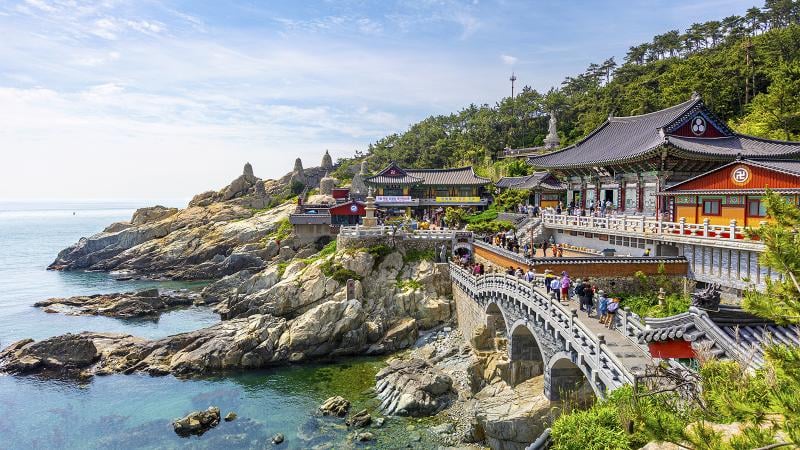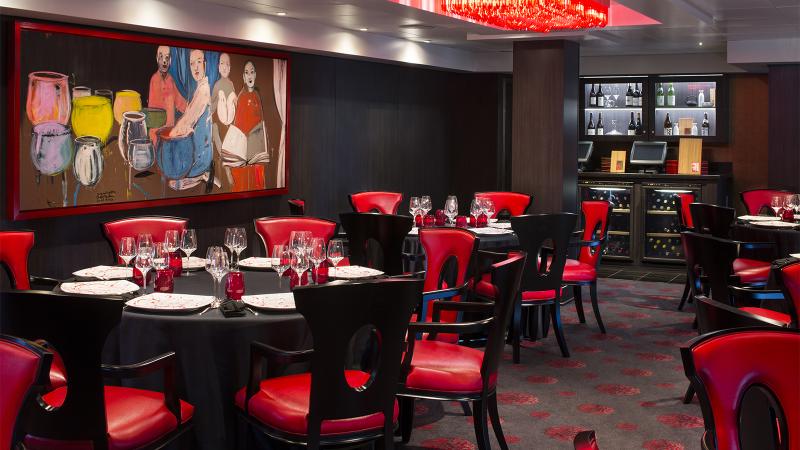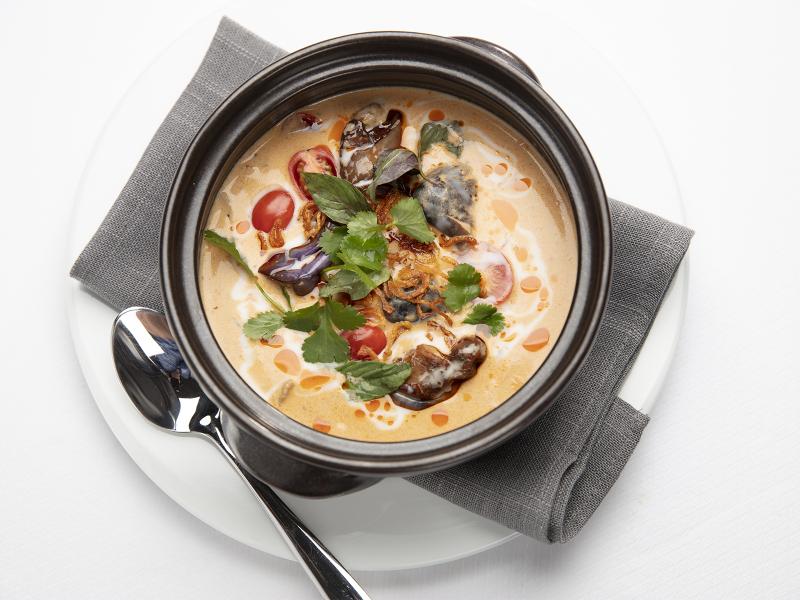For many years, luxury cruise lines have offered Asian specialty dining at sea. But now with burgeoning consumer demand for exotic dishes from Japan, Southeast Asia, India, China and beyond, upscale “Far East” dining experiences at sea have evolved in complexity and style.
Simply put, foodies who love Asian cuisine will find much to love at sea. Here’s a sampling of top "Far East" dining venues and foodie experiences afloat.
Koko’s and Night Market
Luxury Travel Advisor recently dined repeatedly at Koko’s Asian Fusion and Saki Bar and the more intimate, teppanyaki-style Night Market on the 228-passenger Scenic Eclipse, the first oceangoing Discovery Yacht of Scenic Group USA. We felt that both were among our best-ever Asian dining experiences at sea.
Arriving at Koko’s Asian Fusion restaurant, one of two main restaurants on Scenic Eclipse open for lunch and dinner, our first thought also was that “it certainly looks the part” with enigmatic, geisha-style artwork and exotic décor. Many guests dine at individual tables and chairs, but Koko’s also has two large, traditional Japanese-style dining tables that are lower to the ground. Diners don’t sit on the floor as they might in a Japanese home; they simply step down below floor level and then comfortably sit at this traditional table. It sets the mood well, though.
So, what can one order at Koko’s? On one evening, our entrée choices included miso grilled salmon, beef radang, pork tonkatsu, vegetable biryani, and what we ordered, the chili soft shell crab, which was both succulent and tasty. What’s nice is that one can dine repeatedly at Koko’s on a cruise and find varied menus. On another night, entrée choices ranged from a whole roasted fresh fish to Mongolian flank steak, lemongrass grilled chicken and vegetable lo mein. If offered, we’d highly recommend the entrée of Hong Kong walnut prawns—robust in size, delightfully crispy but not over-the-top on the breading, and perfectly cooked.
Koko’s also offers such soups as tom yum goom or vegan tom yum. On another night, soup choices included beef pho and vegan pho. One could also order an Asian vegetable salad with or without tuna, and on another night, the Asian pulled chicken salad or vegan nam tok. Popular appetizers included spinach and garden dim sum, satay and Namerou, consisting of chopped local grated fish, fresh ginger, green onions, golden miso paste and vinegar. Koko’s also offers a good selection of Japanese saki and bar service for diners. Since Koko’s is also a main eatery, no reservations are required.

What’s nifty on Scenic Eclipse is that Koko’s also hosts two other Asian culinary experiences, where reservations are required. One is the Sushi Bar at Koko’s. With seating for 18 guests, this area within Koko’s offers dining at either a bar benchtop eating area overlooking the ocean or along the sushi bar, where guests seated on high-top bar seats can watch expert sushi chefs handcraft the orders. Diners can order everything from miso soup to edamame, hana salt or retasu salad with sesame dressing, and have a wide selection of sushi, sashimi, rolls, temaki and a western-style Aburi Hotati (torched sea scallop) or Aburi Sake (torched salmon).
Nestled into a private room behind Koko’s is Night Market, a second, more intimate Asian venue. A maximum of eight guests will interact with the chef while savoring tasting-menu small plates during a teppanyaki-style experience. Guests can choose from either Asian, Middle Eastern or Indian cuisine nights; each cuisine is typically offered multiple nights. During our Indian night, we savored thali, pani puri tasting and kathy taco, before proceeding to Mumbai (Bombay) duck, lobster samosa (a fried South Asia pastry with a savory lobster filling) and tikka tail. We absolutely watching how the chef crafted the falooda ice roll and Indian popcorn dessert. That was pure entertainment.
Best of all, there is no charge to dine at Scenic Eclipse’s Koko’s, Sushi at Koko’s or The Night Market.
Red Ginger and Pan Pacific
A few months ago, Luxury Travel Advisor also dined at Oceania Cruises’ highly rated Red Ginger while sailing on the 1,238-passenger Marina. This Pan-Asian specialty restaurant is also available on Riviera and Sirena, and will debut on the 1,200-passenger Vista, when that new ship sails on a spring “Founder’s Cruise” that departs from Civitavecchia (Rome) on May 13, 2023.
Reflecting bold, tasteful Asian design, Red Ginger has red fabrics, ebony woods, traditional art, and yes, even a waterfall. As for the cuisine, you’ll find savory Korean, Japanese, Thai, Malaysian and other Asian specialties. Guests choose a tasting menu or order à la carte.
We loved the spicy roast duck and watermelon salad and also suggest trying the chicken satay (with cucumber, red onions, pineapple and peanut sauce). For our main course, we couldn’t resist ordering the lobster pad Thai, which was scrumptious. That said, several fellow guests particularly enjoyed the seven spices crusted lamb rack with fresh Wasabi lamb jus, shitake mushrooms and snow peas.
Red Ginger offers premium sake selections and Asian beers and cocktails are concocted using such ingredients as lemongrass, ginger, turmeric or exotic fruits including lychee. There is no cover charge for Red Ginger.

Guests can also take hands-on cooking classes in the Culinary Center aboard Oceania’s Marina, Riviera and on the soon-to-launch Vista. Guests on Oceania’s Asia cruises can also peruse local foods during shore excursion market visits.
For example, in upcoming port calls for Busan, South Korea, Oceania’s guests taking the four-hour “Beomeosa Temple and Markets” excursion will explore a reconstructed Buddhist temple complex and observe the monks at prayer. But then, they’ll also stroll through the maze-like aisles of South Korea’s largest traditional market and browse stalls brimming with exotic seafood at the Jagalchi Fish Market.
On Regent Seven Seas Cruises’ Splendor, the Pacific Rim dining venue has a varied menu. Starters include beef takaki, a duck confit spring roll, pork and shrimp siu mai, vegetable pot stickers and crispy soft shell crab tempura. For entrees, the choices could range from Canadian lobster tempura to massaman curry (vegetarian), Black Angus New York strip loin, Chinese barbecue pork ribs, Korean-style barbecue lamb chops, aromatic duck or Thai red chicken curry.
Regent Seven Seas offers optional, hands-on culinary classes (varying by type of cuisine and topical theming) within the Culinary Arts Kitchen on Seven Seas Splendor and sisters Seven Seas Explorer and the soon-to-launch Seven Seas Grandeur, debuting in late 2023; each of those ultra-luxury ships carries 750 passengers or so, based on double occupancy. Each Culinary Arts Kitchen is well equipped with workstations that feature induction cooktops, stainless steel sinks and cooking essentials. Guests will receive highly individualized culinary instruction from experts.
In addition, during some Asian itineraries, Regent Seven Seas offers “Spend a Day with a Local Family,” shore excursions. For example, during an upcoming shore trip in Colombo, Sri Lanka, guests spend a day with a family in their home, learn about day-to-day life and join the family in preparing typical local dishes using ingredients such as jackfruit. Then cruisers taste the dishes—diving deep into Sri Lankan culinary traditions.
Kaiseki and Sushi
Another favorite Asian eatery at sea is Silversea Cruises’ Kaiseki. It offers balanced menus inspired by the five elements of Japanese nutritional cuisine and the equilibrium of yin and yang. Teppanyaki is available exclusively at dinner, and daytime menus feature sushi and sashimi.
During our time on the new 596-passenger Silver Dawn in 2022, we ambled into Kaiseki and sampled Wagyu kushiyaki or beef skewers with Japanese mustard sauces, momo yakitori (marinated chicken thigh skewers) and shrimp tempura-battered shrimp balls. Highly recommended for the main course is the Maine lobster tail and Wagyu beef steak—one of the tastiest “surf and turf” dishes we’ve ever had. Kaiseki is also known for its miso-glazed Black Cod. Another option is katsu chicken breast and gohan rice or agedashi tofu. For dessert, we’d opt for Kaiseki’s signature matcha (green tea) ice cream,
Kaisek can be found not only on Silver Dawn but also Silver Muse and Silver Moon. Kaiseki will definitely be aboard Silversea’s two new 728-passenger, Nova-class vessels—Silver Nova, debuting this summer and Silver Ray, arriving in 2024. Note: This restaurant carries no charge at lunch. At dinner, the per person charge is $40.
In addition, on Silver Muse and the 608-passenger Silver Spirit, guests can dine at Indochine, an Asian-fusion restaurant with a contemporary interpretation of traditional dishes from India, Vietnam, Thailand and elsewhere in Asia. The exotic cuisine is inspired by the 1,500 spices and flavors that Marco Polo brought back from Asia to Europe.
Separately, guests sailing through Asia on certain Silversea ships, Silver Moon among them, can enjoy local Asian dishes and beverages at the S.A.L.T. Kitchen and separate S.A.L.T. Bar; it’s all part of the line’s Sea and Land Taste offering, developed by Adam Sachs, former editor-in-chief of Saveur Magazine and now director of the program. Plus, guests can learn to cook certain Asian dishes at the onboard S.A.L.T. Lab
Cruisers also have an opportunity to choose culinary-focused S.A.L.T. shore excursions. For example, on Silver Moon’s 14-day voyage from Singapore to Hong Kong, departing February 29, 2024, the ship calls at Laem Chabang (Bangkok), Thailand, for two days. One new excursion is “S.A.L.T. Healthy Diet & Lifestyle with One-Michelin-Star Chef Vichit Mukura.”

Following a scenic, 40-minute drive to Pattaya in Chon Buri Province, cruisers will visit Mukura’s home. They’ll receive a welcome drink and amuse-bouche, before taking a guided tour of the property and garden to learn about local plants, herbs and spices, including lemongrass and red jasmine rice. Next, guests will sit with Chef Mukura to learn about his life growing up in Thailand, career and decision to join his family in adopting a plant-based diet. Participating in the discussion too will be Chef Mukura’s daughter, Piyarat, a top vegan chef and plant-based nutrition specialist. The chefs then will conduct a plant-based, vegan cooking demonstration. The outing concludes with a plant-based, authentic, four-course Thai lunch.
Seabourn’s Asian restaurant, Sushi, is offered on the Seabourn Encore and Seabourn Ovation. We’ve dined here many times and found its Asian cuisine quite delicious. Hamachi, tuna, shrimp and fresh fish products are shipped directly from Japan to the ship. At dinner, à la carte options include caviar, small plates, maki rolls, sushi, sashimi and salads. At lunch, guests can choose from three varieties of bento boxes—meat, seafood and vegetarian. There is no cover charge for dining at Sushi.
While Seabourn’s first expedition ship, the Seabourn Venture, does not have a stand-alone Asian eatery, it has the next best thing. Between 6 p.m. to 9 p.m. in The Club, a large lounge with live music, the ship hosts “Sushi in The Club,” fielding an extensive menu of sushi, sashimi and rolls. Servers who take drink orders bring a menu and guests may order as much as they want throughout the evening. Also look for Sushi in the Club aboard sister expedition ship, Seabourn Pursuit, launching later this year.
Select Seabourn shore excursions also will interest foodies. For example, Seabourn Encore will sail a 14-day “Thailand, Vietnam and Malaysia” itinerary on February 3, 2024, roundtrip from Singapore. During the ship’s two days in Ho Chi Minh City, one activity is Seabourn’s optional “Night in the Mekong Delta” overland adventure, starting at $429 per person, double occupancy. Travelers will venture to Cai Be, about 60 miles away and stay for one night at the Mekong Riverside Boutique Resort or a similar resort.
They’ll visit the resort’s vegetable and fruit garden, enjoy a sunset cocktail and a cooking class with spring rolls, view the floating market, walk on Tan Phong Island to visit villages (most of the locals sell or trade items from their gardens to make a living) and tour farmers’ homes. Lunch is included.
More Fine Asian Cuisine
In spring 2024, Cunard Line will offer a Pan-Asian specialty dining venue aboard its new Queen Anne. Hapag-Lloyd Cruises’ luxurious, 500-passenger Europa 2 is home to Elements, a restaurant that fields modern style and serves à la carte Indian, Vietnamese, Chinese and other Asian cuisine. In addition, the line’s expeditionary, 230-passenger Hanseatic Inspiration offers Nikkei, a specialty dining venue that serves Japanese–South American fusion cuisine. English and German are official languages on both ships.
Some upscale lines—Ponant, Viking, Azamara and others—don’t have dedicated Asian eateries aboard but offer unique foodie experiences during Asia voyages. For example, on some of Ponant’s cruises that visit Japan, one activity option is a sushi and sake workshop and tastings. Viking offers menus with some dishes that dovetail with the sailing region, shore excursions that appeal to foodies such as a Rayong Tropical Fruit Farm visit during a Laem Chabang (Bangkok), Thailand, port call, and a “Kitchen Table” experience. During the latter, guests become immersed in local culture/cuisine as an executive chef leads them in an interactive experience.
Varying by itinerary, Azamara’s exclusive, complimentary “AzAmazing Evenings” immerse guests in the traditions and culture of a destination and often give them the opportunity to sample local foods and beverages. As for Japanese shore excursions, one Azamara foodie option is the “Inaniwa Udon Noodle and Sake Experience,” starting at $249 per person. Guests will visit a 155-year-old Udon Noodle Factory where noodles are still made by hand and also a local sake brewery. Then, it’s on to an authentic Japanese Udon lunch in Akita, Japan.
Multi-Gen Options
Some contemporary mega-ships are a good choice for multi-generational travel. Luxury guests have the best of both worlds—pampering accommodations and robust dining, entertainment and activities. On many Royal Caribbean International ships, guests can both stay in a top suite and get their Asian foodie fix at Izumi Hibachi & Sushi restaurant.
A four-course meal here includes one starter, two main dishes and one dessert. One tasty starter is the shrimp firecracker spring roll—stuffed with shrimp, crabmeat, and just the right balance of sambal chili and cream cheese. If travelers have a hearty appetite, we’d suggest yaki udon—thick, stir-fried udon noodles topped with grilled chicken, shrimp, beef or tofu.
As for sushi rolls, one guest favorite is the baked snow crab and salmon dynamite roll, which has cool cream cheese and cucumber, spicy mayo, garlic-chili oil, citrus and champagne sauce. Families who are dining with little ones at Izumi Hibachi & Sushi can ask for a kid’s menu, which offers smaller-sized portions of sushi, ramen, tonkotsu and teriyaki.
Separately, Royal Caribbean’s Spectrum of the Seas, the line’s first Quantum-Ultra-Class vessel, now sailing on Southeast Asia itineraries from Singapore, offers several Asian dining venues: Sichuan Red with Asian-inspired cuisine; Teppanyaki, a Japanese experience; and the Noodle Bar for live chef demonstrations and noodles made fresh daily in the Grand Windjammer Marketplace.
Luxury travelers who opt for Norwegian Cruise Line’s suite accommodations in The Haven can go outside that exclusive, ship-within-a-ship enclave to Asian dining venues that are likely to wow their palates. On the new 3,099-passenger Norwegian Prima, guests seeking high-energy dining entertainment should head for Hasuki, where knife-tossing chefs create a fun, teppanyaki-style dining experience. All guests receive edamame, miso soup, seaweed salad, an entree and dessert (green tea cake or fresh fruit sashimi) for a $59 cover charge. At Norwegian’s new Indulge Food Hall on Norwegian Prima, guests order from iPads on their dining table or counter. That hall’s Tamara menu spotlights Indian specialties—fish tikka, chicken korma, tandoor vegetable salad and more. Separately, the ship’s Food Republic serves up sharing plates, grill items, noodles, rice and hand-held dishes—everything from pork belly kushiyaki to spicy Korean fried chicken.

On MSC Cruises’ 2,550-passenger MSC Orchestra, those staying in the upscale MSC Yacht Club can head beyond that exclusive complex to the Shanghai Asian Restaurant. Offering Japanese, Chinese and Thai cuisine, it’s the spot for nigiri, sashimi, maki, temaki, dim sum, noodles, shrimp satay, chicken satay and much more. Or, if sailing on MSC Meraviglia from Port Canaveral, FL, this winter season, why not amble over to Kaito Teppanyaki for a fun dinner show? Plus, the Kaito Sushi Bar offers hand-crafted sushi and sashimi.
Demonstrating just how much contemporary lines have elevated their suite and dining options is Carnival Cruise Line, which just appointed famed Chef Emeril Lagasse as the fleet’s chief culinary officer. Varying by ship, the line’s Asian specialty dining includes JiJi Asian Kitchen, Bonsai Sushi, Bonsai Teppanyaki and Chibang (Chinese and Mexican dishes). We’d suggest grandparents hosting a family group on the new 5,374-passenger Carnival Celebration reserve one of the 476-square-foot Excel Presidential Suites for themselves; these pampering suites have concierge service, access to the Loft 19 retreat and 646-square-foot private balconies with double daybeds, a lounging area and hot tub.
Heading into 2023, one fact is clear. Luxury travelers have many more seagoing options for sipping and savoring the flavors and culinary dishes of Asia.
Global Food/Beverage Tidbits
Foodie fans have an enticing choice of three Windstar Cruises’ culinary cruises hosted by James Beard Foundation-affiliated chefs this year. In one example, Chef Ayesha Nurdjaja, a “2022 James Beard Restaurant and Chef Award” nominee for “Best Chef: New York State,” will host Wind Surf’s voyage departing June 17, 2023, from Venice, Italy, to Athens, Greece. She’s the executive chef at Shuka in New York City’s SoHo neighborhood plus sibling restaurant Shukette.
In 2023, Oceania Cruises will debut new fleetwide rum and whisky programs in partnership with Edrington. New Macallan experiences will include a Macallan Diamond Bar Cart, a flight program and a Macallan chocolate pairing. In addition, Brugal 1888 Doblemente Anejado Rum will be featured in a new mixology class, tea pairings, a “Nearly Neat Serving Cart” as well as ice cream and Brugal cocktails.
In addition, Oceania will debut a new bar program on the 1,200-passenger Vista, debuting on May 20, 2023. Look for the latest cocktail-crafting trends and techniques using flavored smoke bubbles, many low- and no-sugar wines, zero-proof cocktails and Negronis aged in wooden barrels. New specialty beverage carts will include the Bubbly Bar and Ultimate Bloody Mary Bar. We can’t wait for the new Moet & Chandon Champagne three-course pairing.
Related Articles
Seabourn Announces 2024/25 Expedition Voyages
Explora Journeys, Pelorus Partner for Destination Experiences
Ponant, Paris Opera Ballet Partner for Themed Cruise in 2024